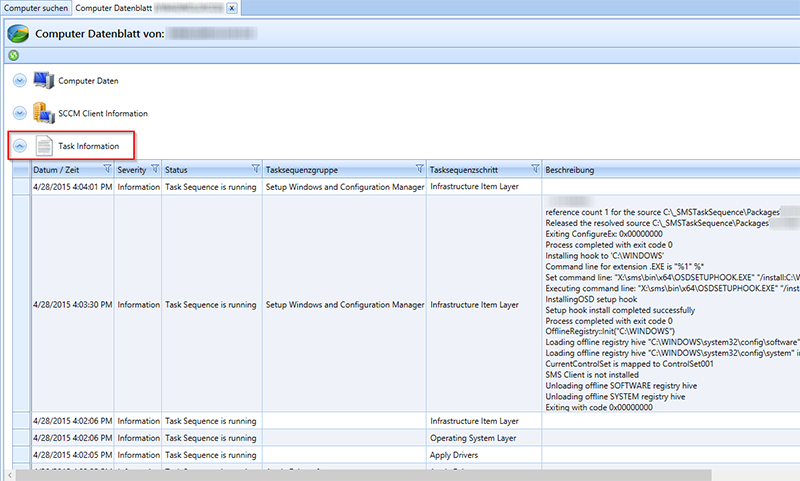OS Deployment
Operating system deployment provides the ability within SCCM to deploy a Windows operating system to managed computers as well as unmanaged computers via bootable media.
- Managed computers
- Computer with operating system and SCCM client
- Unmanaged computers
- Computers with operating system without SCCM Client
- Computers without operating system (Bare Metal Deployment / Initial Installations)
Using a bootable medium such as a USB memory stick or network boot via PXE, the operating system is made available.
To include new systems such as desktop, notebook or tablet in the management of SCCM, a standardized operating system installation is performed. The process is initiated via the SCCM Manager plug-in „Client Creator“.
The Client Creator initiates an automatic operating system installation in which all drivers and software products defined as standard are installed. This process within SCCM is called a task sequence.
Client Creator
The Client Creator plugin can be found pre-installed within the computer administration, which can be reached via the function groups. After selecting the Client Creator plugin, a new tab opens:
In order to achieve a high degree of standardization, a large number of predefined values (computer variables) can be made available here via selection fields. (Further information in the associated Pluginbeschreibung).
Example configuration
The following fields are to be filled in or selected according to a sample configuration:
Internal fields
Operating system (selection)
All currently released operating systems are listed here.
Computername (Text)
Here the computer name is to be entered, this must be deposited in capital letters, without special characters and with maximally 15 characters. A syntactical check is performed automatically.
MAC address (text)
The MAC address of the computer to be installed is specified here.
Computer variables
Domain name (selection)
All domains in which a client may be set up from this server are listed under this selection field.
Name of the OU (selection)
The LDAP string of the OUs in which the computer is to be located after the installation is entered here.
Location / Site (Selection)
The "Location" selection field is used to determine the location where the computer is to be used later. The locations are used to determine, among other things, the settings and software products that apply to a computer.
Environment / Role (selection)
The role is used to determine the area of application of a computer. Specific settings and software products for the system are also linked to the selected role.
Assign collections
By clicking the Assign Collections button, you can add other collections to the computer, besides the software that will be installed in the task sequence.
Applications (software installations) are linked to these collections and installed after the task sequence. There are two options to choose from. One is via Add, which allows to select from all installation collections. The other is the Migration option. With this option, collections can be taken over from an existing computer.
If the Add option is selected, a dialog for selecting collections opens. All shared installation collections can be selected here. By selecting the collections, the corresponding applications are installed after the task sequence is run. To add the desired collection, it is selected and added via the plus sign.
If the Migration option is selected, the migration window opens. Here you can select from the available computers on the left side. If a computer is selected, all installation collections in which the selected computer is located are displayed on the right side. The required collections are selected from the computer's collections. Use the Apply button to add the checked collections.
Import
To create multiple computers at the same time and include them in the SCCM environment, a predefined list can be imported.
To do this, click on the "Import" button.
A window opens in which the comma-separated .txt file to be imported is selected.
The file to be imported must be in the following format:
<COMPUTERNAME>,<MAC-ADRESSE>
It is important that the computer name is written in capital letters. A comma is used as separator between computer name and MAC address.
The imported computers are now displayed at the bottom of the Client Creator. If, for example, an incorrect MAC address is stored in the .txt file for a computer, a corresponding description text will appear in the Error column and the corresponding computer cannot be created. If the Import function is used, the two fields "Computer name" and "MAC address" in the upper area of the Client Creator remain empty. In order for the computers to be included in the task sequence collection, the "Create" button must be clicked.
USB boot with WinPE
In order to equip a computer with the new operating system, it must be booted into the SCCM-WinPE environment.
For this, the corresponding USB stick must be connected to the computer during the boot process.
In addition, it must be ensured via the boot sequence or via the boot selection menu that the USB stick is used as the first boot medium.
After the boot process the installation of the client starts. After formatting the hard disks, the USB can and should be unplugged. This prevents booting from the USB stick again during a reboot. From this point on, the automated operating system installation is performed. During this process the computer can reboot several times.
Task information
To get information about the progress of the task sequence and thus about the operating system distribution of a computer, the "Computer Datasheet" plugin is used. The plug is located within the "Computer Management" function group. There a new tab opens after starting the plugin.
Within the Task Information item, the current status of the operating system distribution is displayed.
Task sequence log
Additionally, the "Custom Logs" plugin offers the possibility to display specific logs.

